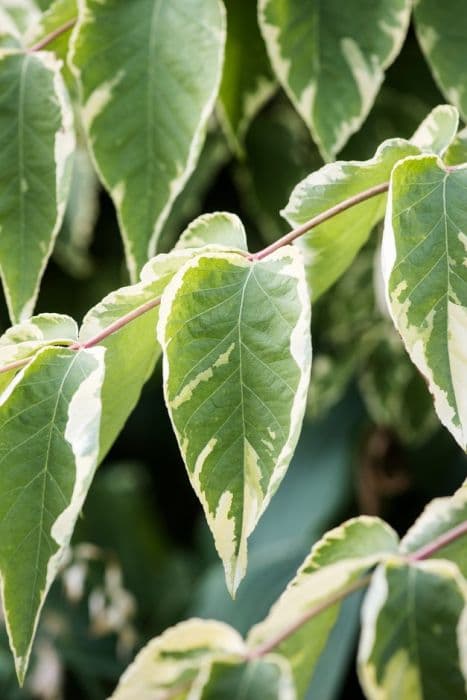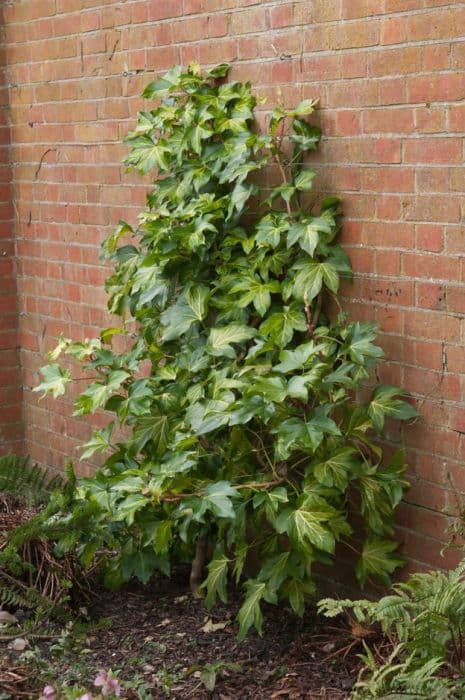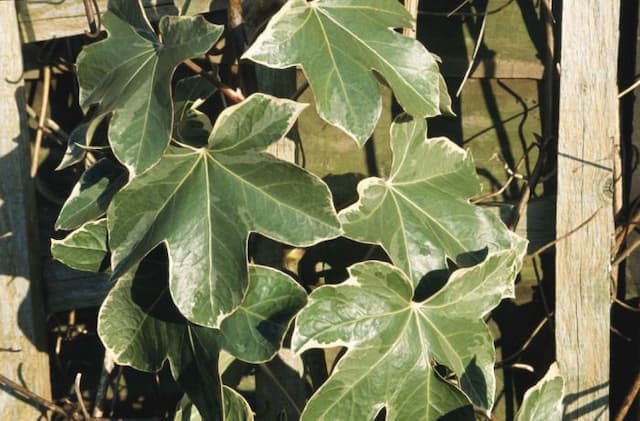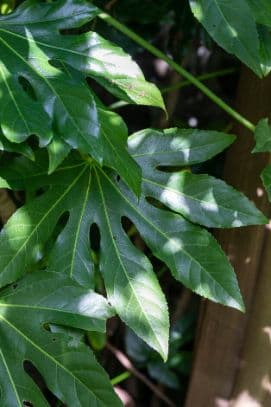English Ivy Hedera helix 'Maple Leaf'

ABOUT
Hedera helix 'Maple Leaf', often known as English ivy, is a visually intriguing cultivar characterized by its unique leaf shape and variegation. The plant showcases leaves that are reminiscent of maple leaves, with deep lobes that lend a somewhat star-like silhouette. These leaves are a lush green, often with a slightly glossy finish that catches the light and adds to the plant's visual interest. This variety of English ivy can display leaves with white, cream, or yellowish markings that create a variegated effect. The variegation patterns might be along the veins, at the edges, or in a mottled distribution across the leaf surface. In addition to its ornamental foliage, the texture of the leaves can vary, often feeling somewhat leathery and sturdy to the touch. Like its parent species, 'Maple Leaf' English ivy is a climbing or ground-creeping evergreen plant, with stems that can attach to surfaces via small root-like structures known as aerial rootlets. These rootlets allow the plant to climb and cover structures, which makes it a popular choice for green facades, trellises, and as ground cover in garden designs where vertical or horizontal spreading is desired. The overall appearance of 'Maple Leaf' English ivy is one of rustic charm and versatile beauty, making it a favored choice among gardeners and landscapers seeking form, function, and year-round foliage interest.
About this plant
 Names
NamesFamily
Araliaceae.
Synonyms
English Ivy, Common Ivy, European Ivy.
Common names
Hedera helix 'Maple Leaf'.
 Toxicity
ToxicityTo humans
The common name for Hedera helix 'Maple Leaf' is English ivy. English ivy is poisonous to humans if ingested. The symptoms can include abdominal pain, vomiting, and diarrhea. Additionally, contact with its sap can cause dermatitis or skin irritation in some individuals. If ingested in large quantities, poisoning from English ivy can result in more serious symptoms such as difficulty in breathing, fever, polydipsia (excessive thirst), delirium, hallucinations, and could potentially lead to a coma. Medical attention should be sought immediately if ingestion or serious symptoms occur.
To pets
English ivy is also toxic to pets. If an animal ingests any part of the plant, it can exhibit symptoms such as vomiting, abdominal pain, hypersalivation, and diarrhea. In severe cases, English ivy ingestion can cause ataxia (loss of coordination), difficulty breathing, and occasionally, coma or death in pets. It is important for pet owners to prevent their animals from accessing parts of this plant and to seek veterinary help if they suspect their pet has ingested any.
 Characteristics
CharacteristicsLife cycle
Perennials
Foliage type
Evergreen
Color of leaves
Varies
Height
6-9 feet (1.8-2.7 meters)
Spread
3-50 feet (1-15 meters)
Plant type
Climber
Hardiness zones
5-9
Native area
Europe
Benefits
 General Benefits
General Benefits- Aesthetic Appeal: English Ivy 'Maple Leaf' adds a classic and timeless look to gardens and indoor spaces with its uniquely shaped leaves and dense, lush foliage.
- Versatility: It can be used in various applications, including as a ground cover, climbing vine, or indoor potted plant, due to its adaptable growing habits.
- Low Maintenance: This plant requires minimal care once established, making it a great option for busy gardeners or those new to plant care.
- Tolerance to Various Light Conditions: It can grow in a variety of light conditions, from full shade to filtered sunlight, providing flexibility in placement and landscaping designs.
- Seasonal Interest: English Ivy provides year-round greenery but can also display seasonal changes with new growth or in response to cooler temperatures.
- Erosion Control: When used as ground cover, the plant's dense growth habit can help prevent soil erosion in the landscape.
- Wildlife Habitat: The dense foliage can provide shelter for birds and other small wildlife, contributing to biodiversity in the garden.
 Medical Properties
Medical Properties- Expectorant: The plant has been used to help loosen phlegm and relieve chest congestion.
- Anti-inflammatory: It may have anti-inflammatory effects, useful in treating conditions like arthritis.
- Analgesic: Has been historically used as a pain reliever for various ailments.
- Antispasmodic: Could be helpful in relieving muscle spasms.
- Antimicrobial: Exhibits properties that may inhibit the growth of certain bacteria and molds.
 Air-purifying Qualities
Air-purifying QualitiesThis plant is not specifically known for air purifying qualities.
 Other Uses
Other Uses- Hedera helix 'Maple Leaf', commonly known as English ivy, can be used in topiary gardens for its ability to climb and cover structures, allowing gardeners to shape it into various forms.
- English ivy can be used in erosion control as its roots help to hold the soil in place on slopes and prevent landslides.
- English ivy is often planted in urban spaces to cover unsightly walls and buildings, providing an aesthetic green facade.
- It can be used for holiday decorations, as the vines and leaves can be woven into wreaths or used as garlands.
- English ivy has been utilized as a natural dye for textiles, offering a range of green hues.
- When planted in a hanging basket, English ivy can create an elegant curtain of foliage as it cascades over the sides.
- Used in landscape design, English ivy can form a living mulch ground cover that suppresses weeds and retains soil moisture.
- In film and theatre, English ivy may be employed to create an aged or romantic setting due to its association with old buildings and gardens.
- English ivy can be used in crafting, such as making natural crowns or headpieces for costumes and festivals.
- It can be incorporated into living walls or vertical gardens, both indoors and outdoors, as it thrives in vertical growing conditions.
Interesting Facts
 Feng Shui
Feng ShuiThe English Ivy is not used in Feng Shui practice.
 Zodiac Sign Compitability
Zodiac Sign CompitabilityThe English Ivy is not used in astrology practice.
 Plant Symbolism
Plant Symbolism- Connection: English Ivy, including the 'Maple Leaf' variety, is often considered a symbol of connection and friendship because of its tendency to intertwine and cling to structures and other plants.
- Eternal Life: The evergreen nature of English Ivy signifies eternal life and immortality, as the plant stays green throughout the year and is very hardy.
- Fidelity: Owing to its clinging nature, it is also a symbol of fidelity and enduring affection, as it stays attached to a surface once it starts growing.
- Protection: English Ivy is believed to have protective qualities, often planted around homes to act as a safeguard and to bring good luck.
- Resilience: Its ability to grow in challenging conditions represents resilience and the ability to overcome adversity.
- Dependence: Since it relies on structures or trees for support, English Ivy can sometimes symbolize dependence on others.
 Water
WaterEnglish ivy should be watered when the top inch of soil feels dry, about once a week. Use lukewarm water, and gently pour it directly onto the soil until it begins to run out of the drainage holes in the bottom of the pot, ensuring the plant is thoroughly hydrated. Depending on the size of the pot and the climate, this might be equivalent to about 16 to 32 ounces of water each time. During the active growing season in spring and summer, you may need to water more frequently, while in the dormant winter months, reduce watering to every other week.
 Light
LightEnglish ivy thrives in bright, indirect light but can also adapt to low light conditions. It's best positioned in a spot where it will receive ample indirect sunlight throughout the day, away from direct afternoon sun which can scorch the leaves. An east or north-facing window would be an ideal location, providing consistent light without the intensity of direct southern exposure.
 Temperature
TemperatureEnglish ivy prefers an average room temperature of 60-70 degrees Fahrenheit but can tolerate temperatures as low as 50 degrees and as high as 85 degrees. It's important to protect the plant from sudden temperature swings and cold drafts, which can damage the leaves. The ideal temperature for the English ivy to thrive is between these ranges, without exposure to extreme heat or cold.
 Pruning
PruningPrune English ivy to maintain its shape, encourage bushier growth, and remove any dead or damaged foliage. It can be pruned at any time of the year, but the best time is in the spring, right before the new growth starts. Use clean, sharp scissors or pruning shears and cut just above a leaf node. Pruning can be done as often as needed to keep the plant at a desired size or appearance.
 Cleaning
CleaningAs needed
 Soil
SoilEnglish ivy prefers well-drained soil with a mix of peat, perlite, and organic matter, enhancing moisture retention and drainage. The ideal soil pH for English ivy is between 5.5 and 6.5.
 Repotting
RepottingEnglish ivy should be repotted every two years in spring to keep the root system healthy. Over time, it may need more frequent repotting if it grows vigorously.
 Humidity & Misting
Humidity & MistingEnglish ivy thrives in moderate to high humidity levels, ideally between 40% to 60%.
 Suitable locations
Suitable locationsIndoor
Bright light, moderate water, no direct sun for English ivy.
Outdoor
Plant in shade or part sun, water regularly.
Hardiness zone
English ivy is suitable for 4-9 USDA zones.
 Life cycle
Life cycleEnglish Ivy 'Maple Leaf' begins as a seedling, emerging from seeds that have been dispersed naturally or through human intervention. As the seedling establishes roots and sprouts its first leaves, it enters a vigorous vegetative stage, where it grows rapidly with its distinctive maple-leaf shaped foliage. During this time, it also clings and climbs using aerial rootlets, which allow it to ascend structures or spread across the ground. Once mature, it may develop clusters of small, greenish-yellow flowers in the fall, which are less noticeable than its foliage. Following flowering, if pollinated, the plant may produce berry-like fruits that turn dark blue to black when ripe, consequently attracting birds that aid in seed dispersal. As a perennial, English Ivy can live for many years, repeating its flowering and fruiting cycle annually while continuing to expand its reach.
 Propogation
PropogationPropogation time
Spring-Early Summer
The most popular method for propagating the English Ivy 'Maple Leaf' is through stem cuttings. The ideal time to propagate is during spring or early summer when the plant is actively growing. To propagate, take a cutting of about 4 to 6 inches (10 to 15 centimeters) long, ensuring that it includes at least 2 to 3 sets of leaves. Remove the leaves from the lower half of the stem to expose the nodes. These nodes, when in contact with soil or water, will develop roots. Dip the cut end of the stem in rooting hormone to enhance root development, although this step is optional. Place the stem cutting in a container filled with a mixture of potting soil and perlite or directly into water. If using soil, keep it consistently moist but not waterlogged, and provide the cutting with bright, indirect light. New roots typically emerge within a few weeks, after which the new English Ivy plant can be transplanted to its permanent location.









